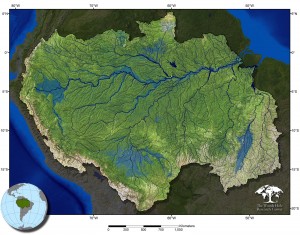
Rardiles Branches
I am currently studying the behavior of carbon dioxide in the Amazon River and the correlation with the physical and chemical water parameters. I attend the Federal University of Western Pará (UFOPA), studying engineering and geosciences. I last three years I have participated in the BRAMA (THE AMAZON BIOGEOPHYSICAL AND MODELING ENVIRONMENT) group and the Amazon River Observatory project as a fellow of the scientific initiative. I have also taken part in the campaigns on the Amazon River and the Go Amazon project in partnership with Woods Hole Research Center (WHRC) / UFOPA , INPE, INPA/UEA and Pennsylvania State University (PSU) in the National Reservation of Cuieiras (ZF2). |

Kristina Brown
I have always been interested in the connections between rivers and the ocean, especially in the Arctic where I carried out my PhD research. My research focuses on tracing carbon and fresh water pathways within the Arctic Ocean using the geochemical “fingerprints” of their different sources. As a Postdoctoral Scholar at the WHOI Coastal Ocean Institute, I will investigate the biogeochemistry of rivers flowing into the Canadian Arctic Archipelago and evaluate the impact of the carbon and freshwater they deliver to the marine environment. |

Ana Luzmila Sánchez Calderón
Ana Luzmila Sánchez Calderón recieved her Hydrobiology PhD from the University Paul Sabatier, Toulose, France and her MS from the University of the Andes. Bogotá. She was the Director for 10 years and researcher in Limnology (30 years) at Hydrobiological Research Station Guiana La Salle Natural Science Foundation in Venezuela.
She participated in the coordination and implementation of various projects related to the spatial and temporal variation of phytoplanktonic an periphytic communities and their relationship with changes in the physic-chemical variables in environments of the Orinoco River Basin (main channel, tributaries, floodplain lakes, reservoirs).
Currently, she works as an independent consultant in Continental Aquatic Ecology. She actively participates as a “visiting contributor” in the development of research programs at the Laboratory of Soil Ecology of Venezuelan Institute for Scientific Research (IVIC). |
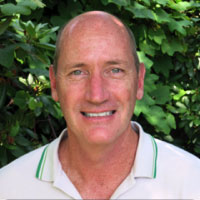
Michael T. Coe
I’ve worked on many rivers throughout the world as an earth system scientist specializing in human impacts on river systems, but for the last 15 years I have been focused on the Amazon Basin. I am trying to provide a clearer understanding of how deforestation in the rainforest and savanna biomes of South America are altering the climate and rivers. I have been concentrating on the undesirable changes that may occur because of these impacts, and possible strategies for avoiding or mitigating these negative effects. I work at a variety of scales, from the farm field to the entire 6.7 million km2 watershed. The Amazon River is truly a special place and I look forward to sharing it with you. |
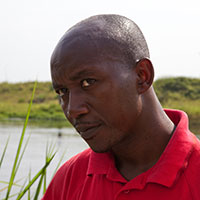
Jean Bienvenu Dinga
The Congo Basin is the second most powerful river in the world after the Amazon; it is the best possible place for my science. Hydrology and water chemistry of the Congo River led me through Max Holmes in the USA especially WHRC then by Bernhard Peucker-Ehrenbrink at WHOI. The expedition on the Amazon will allow me as Head of the Hydrological Service of my country to realize a dream to compare in-situ the physical chemistry of the water of the two largest rivers in the world (Congo and Amazon). Success in building the Global Rivers Observatory! |

Greg Fiske
I am currently the Geographic Information Systems (GIS) manager and chief cartographer at Woods Hole Research Center. I have been working with global-scale river related geospatial data since 1999. Bridging the gap between art and science, I believe that maps are the ultimate tool for communication. My interests include the use of maps and geospatial technology to facilitate and communicate earth systems science. My day-to-day activities include managing the many technical aspects of the Center’s GIS activities, cartography, developing computer code, and complex spatial modeling and analysis. |

Laura Lee Grace
I grew up in the Kansas City area where I am currently living. I graduated from Wellesley College in 1960. I have two daughters: one in New Hampshire and one in New York City and also three grandchildren all in their teens. I have been painting for 15 years using mostly oils on canvas; my work can be seen at LauraLeeGraceArtist.com.
For the last 35 years I have been involved with the work of Professor Roy Prosterman at the University of Washington School of Law. He began the project of Democratic Land Reform (Landsea), and over the last 36 years it has grown in over 40 countries and has brought beneficial changes for millions of farm families. Roy has been nominated four times for the Nobel Peace Prize. Landsea’s mission is to secure land rights for the world’s poorest farmers including women. Receiving secure land tenure rights changes everything. When the land belongs to a farmer and not a landlord, sweat equity will be invested in crop production. When land rights are secure the cycle of poverty is broken.
I am also interested in general aviation flying and over the course of seven years (in the 1970s) I earned my Pilot’s License, then my Instrument Rating and finished off with my Twin Engine Rating in a Cessna 310. I also received a Glider Pilot Rating at the Black Forest Glider Port in the Colorado Springs area.
My sister, Georgie McConnell, has been telling me for quite awhile about the fascinating meetings she has been attending at WHOI. That inspired me to participate in the Amazon River Science Expedition. |

N. Stuart Harris MD MFA FRCP Edin.
Stuart is the Chief of the Division of Wilderness Medicine at Massachusetts General Hospital and Assistant Professor of Surgery at Harvard Medical School. His team has been working with Dr. Holmes over the last three years to provide medical support and risk mitigation for the scientists and students of the Polaris Project / WHRC. His team studies how changes in the environment influence human health, most recently by investigating Vitamin D levels and mercury poisoning in the citizens of Cherskiy, Siberia. |

Jordon Hemingway
I’m currently a fourth year Ph.D. student in the MIT/WHOI joint program studying riverine carbon export from many rivers around the world. My work relies mostly on biomarkers – compounds produced by a specific group of organisms – and their associated isotopes to determine the source of organic carbon in rivers. With my thesis advisor, Valier Galy, and committee members Rob Spencer and Bernhard Peucker-Ehrenbrink, I’ve been applying these techniques to time-series samples in various rivers to determine how carbon export changes with varying climatic conditions. |

R. Max Holmes
I’ve loved rivers for my whole life, first as a small kid flipping over rocks in Northern Michigan streams looking for bugs, then as an angler, and finally as a scientist. My love of “mucking about in streams” has never waned, and my scientific curiosity about what we can learn about our changing planet by studying river chemistry and discharge continues to grow. Much of my research takes place in the Arctic, but an increasing amount is done in the tropics, including on the Amazon and Congo rivers. I’m thrilled that the Global Rivers Observatory’s idea of a series of “floating workshops” is finally getting underway, and that we’re starting on Earth’s largest river by far, the Amazon. I’m also thrilled that the trip will combine world-class scientists with students and a fascinating group of supporters of WHOI and WHRC. This is certainly a unique blend of participants for a scientific expedition and will almost certainly yield unique and unpredictable results. My hope is that our successes will greatly exceed our challenges and that this will be the first in a series of floating workshops on the great rivers of the world. |

Weston (Tony) Howland
I took my undergraduate degree at Ohio Wesleyan University, with a major in Psychology. I earned my Chartered Financial designation in 1984 and run an investment advisory firm in Boston that serves families and individuals. I love being the outdoors and enjoy, depending on the season and location, birding, fishing, hunting, hiking, sailing or skiing. |
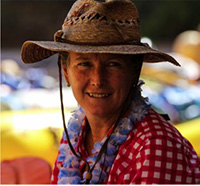
Susanah Howland
I am a painter and printmaker. I graduated from the College of William and Mary with majors in Art and Cultural Anthropology and was a natural science illustrator for twenty‐five years. A keen observer of the world around me, I love being outdoors‐ gardening, horseback riding, hiking and fishing, travelling‐ always with sketchbook in hand. |
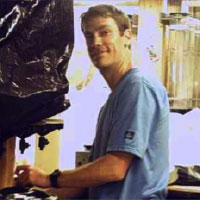
Carl Lamborg
Most of my research is centered around understanding the fate of mercury in the environment. At WHOI, I’ve been particularly interested in flow of mercury to the ocean in underground estuaries where groundwater enters the ocean. Through that work, I’m gaining an appreciation for the importance of freshwater as a vehicle for mercury to enter the ocean…and I’m excited to see what role the world’s largest river plays in that process. But also because there are serious mercury problems in Amazonia, as mercury is used in the small-scale gold mining that is now proliferating in the region. |

Chris Linder
I am a professional science and conservation photographer. My goals as a photographer are to educate the public about science, inspire the next generation of scientists, and communicate the need to preserve wild places. In the last ten years, I have documented over 40 scientific expeditions, including Global Rivers fieldwork in the Congo, Amazon, and Fraser River basins. My images have appeared in museum exhibits, books, calendars, documentary films, and magazines worldwide. I am the author of Science on Ice: Four Polar Expeditions (University of Chicago Press). |
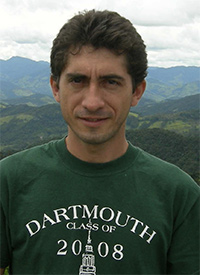
Jose Mauro Maura
I am an Assistant Professor at the Federal University of Western Pará (UFOPA). I have a degree in Biological Sciences from the Federal University of Pará -UFPA (2000), a MSc (2005) in Ecology of Agroecosystems, and a PhD (2010) in Chemistry in Agriculture and Environment, from the Center for Nuclear Energy in Agriculture (CENA). My experience is in the area of biogeochemistry of aquatic and forest ecosystems, with an emphasis on the flow of organic and trace gases (RN-222 and CH4). I use stable isotopes of carbon, nitrogen and oxygen, and study gas flows in rivers and soils, and measures vertical profiles of tropical forests.
Luckily I grew up seeing the biggest (Amazon) and one of the most beautiful (Tapajos) rivers in the world, meeting in front of my city. I’m from Santarem and a few years ago I returned to my home city to work as professor at the same university I graduated from. However, just the pleasure of seeing the rivers was not enough. I wanted to understand their behavior and functioning….so, after finishing my PhD I decided to get into the water… |

Michael and Georgie McConnell
We were first introduced to WHOI in 2003, at an event held in New York City. Not long afterward, we visited Woods Hole and toured the Quissett Campus, meeting several of the scientists, as well as members of the administration. Georgie joined the Corporation in 2004, and became a trustee in 2007. She focuses on communicating to a wider audience the value of the cutting edge science and advanced engineering being done at WHOI. She wrote the booklet WHOI Orientation in an effort to present a coherent picture of this unique and rather complicated organization to interested outsiders and newcomers to the Corporation.
Our principle residence is on Shelter Island, New York. Michael is an avid fisherman, and ventures throughout the nearby waters. He recently completed an eleven year commitment to The Nature Conservancy Mashomack Preserve and served as its chairman for three years.The Preserve occupies nearly one third of Shelter Island. Our interest in the coastal waters includes issues of shellfish health, fish populations, algal blooms, nitrogen loading due to septic systems, and much more.
Michael retired as Managing Partner of Brown Brother Harriman and Co. in 2008, but remains a partner in the firm, giving advice and oversight to the firm.
We have been fascinated by the Amazon River ever since reading The River of Doubt, chronicling Teddy Roosevelt’s trip in 1912. Georgie heard a talk by Bernhard about a year ago, on his study of the major rivers of the world.
We are excited to be in the company of scientists from both WHOI and the Woods Hole Research Center. We have no doubt we will be given intriguing insights into the entire ecosystem of the Amazon Basin. |
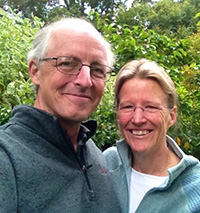
Wil Merck and Nonie Brady
Wil Merck and Nonie Brady live in Hamilton, Mass. and have had a variety of involvements with the environment, and environmental activism. During his investment business career, Wil served on the board of the New England Forestry Foundation. He then founded the Essex Timber Company, LLC, a timberland management company. He has been a Trustee of the Merck Family Fund for many years. Wil has been a director of the Woods Hole Research Center since 2005, and has been chairman since 2011.
Nonie is an activist for local agriculture and farm-based education. She created the cooking program at Appleton Farms and is now at the center of The Three Sisters Garden Project, both in Ipswich, Mass. She began her career with Boston Urban Gardeners thence to Outward Bound, the New York textile industry and The Marion Institute.
Neither of us has been to the Amazon, but we plan to bring River of Doubt for a little light reading, and maybe Heart of Darkness as well. |
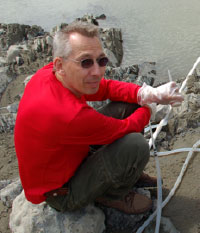
Bernhard Peucker-Ehrenbrink
Rivers have been at the center of my research for the past decade. It took me a decade after my dissertation in Germany and move to WHOI to realize that rivers are the key to understanding the chemical evolution of seawater. Together with Max Holmes and colleagues at WHOI, WHRC and many other institutions in the US and abroad, we have built the Global Rivers Observatory, a global network of observing stations on large rivers. The Amazon is one of the newest additions to this network. Although I have analyzed many samples from this river, this is my first visit to the Amazon |
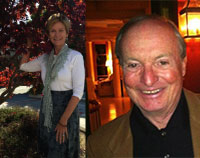
Amy and Jay Regan
Amy and Jay Regan live on a farm outside of Princeton, NJ. They have three adult children living on the west coast and eight grandchildren. Amy has been a Board Member of Woods Hole Research Center for 15 years and is president of Harbourton Foundation, a family foundation, addressing the environmental crisis through food systems and climate change. The Foundation is a supporter of the Global Rivers Observatory project. Jay after graduating from Dartmouth College headed to Wall Street and went into the investment business. He ran a hedge fund for 22 years and now manages our family office with our oldest son. We have never travelled to the Amazon and are excited do so, and have the opportunity to be part of the conference. |
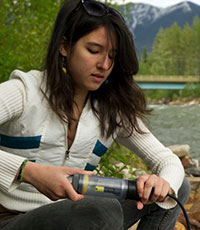
Sarah Rosengard
I am in my fourth year in the Woods Hole Oceanographic Institution/MIT graduate program. Under the guidance of my advisors (Valier Galy, Phoebe Lam, and Robert Spencer), I track the movement of particulate organic carbon, produced from carbon dioxide by algae and land plants, into the deep ocean, where it resides for periods of hundreds to thousands of years. Specifically, I investigate the processes that influence the composition of this organic matter as it transits two globally significant sites of carbon storage: the Southern Ocean and, more recently, the Amazon River. Since first visiting the Amazon River Basin in college, graduate school has fulfilled my hopes of returning to Brazil, and provided me with a fresh lens to address environmental questions in this region. I hope that the data I collect here will improve scientific understanding of the Amazon’s contribution to carbon sequestration in the Atlantic Ocean. |
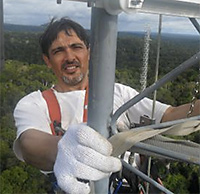
Julio Tota da Silva
Julio Tota da Silva has a BS in Meteorology, MSc in Meteorology and PhD in Climate and Environment at INPA-UEA. He is a researcher and permanent teaching professor at the Graduate in Climate and Environment (CLIAMB) at both INPA and the University of Amazonas State (UEA). He is currently assistant professor and coordinator of the Undergraduate Program in Atmospheric Sciences, Federal University of Western Para (UFOPA). |
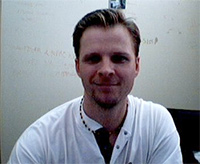
Rodrigo da Silva
Rodrigo received his Ph.D. (2006) in Physics from the Federal University of Santa Maria. His PhD was in cooperation with the State University of New York (SUNY) within the LBA program. In 2005 he moved to the Amazon to carry out technical-scientific coordination of experimental sites during the LBA program. In 2006 he became an Associate Professor at the Federal University of Pará (UFPA) in Santarém, PA. He was part of the team that designed and implemented Undergraduate Studies in Environmental Physics Licentiate. In 2012, he became Coordinator of the Graduate Program in Earth Sciences (CPTG) of the Federal University of Western Pará (UFOPA) conducting partnership studies with the national research groups of: UFSM, UFPA, MPEG, INPA, INPE, USP / CENA / ESALQ, Campinas, EMBRAPA, SIPAM; and the international groups: State University of New York (SUNY); University of Arizona (UA); Harvard University, University of Washington and University of Cambridge. His experience is in Geosciences and Physics, with an emphasis on Micrometeorology, focusing on the following subjects: – Physics of Climate in the Amazon and its relation to changes in land use and global climate change. His studies are focused on the confluence of the Tapajós and Amazon Arapiuns region and the region of influence of the BR-163 (FLONA). |
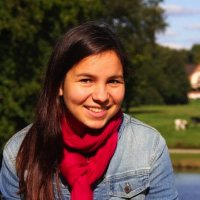
Anya Suslova
I graduated in June from Teri University in India with a master degree in Climate Science and Policy. Born in the Arctic indigenous village of Zhigansk, I was a citizen scientist before there was “citizen science”. Collecting samples as a teenager on the Lena River shaped my current interest, which bridges climate science and indigenous peoples. For my masters I researched the resilience of arctic population to climate change. |

Zhaohui ‘Aleck’ Wang
I am a marine chemist/geochemist, and my research focuses on studying the aquatic carbon dioxide (CO2) system, ocean acidification and developing in-situ sensors to measure CO2 system parameters, including pH, CO2 concentration, and alkalinity. The aquatic CO2 system is very important because it determines the acid-base property of water and regulates how an aquatic system ‘breathes’ in or out carbon dioxide. This will affects the carbon dioxide level in the atmosphere, thus the Earth climate. During the last four years, I have been making measurements of the carbon dioxide system at a handful of major and local rivers around the globe, with the aim to understand how and why river acidity and carbon dioxide fluxes vary on different spatial and temporal scales and examine if and how human activities may play a role. Studying the riverine carbon dioxide system in the Amazon is my next target. |



